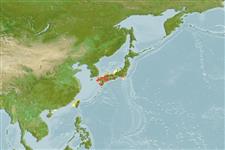Klassifizierung / Names
Namen | Synonyme | Catalog of Fishes(Gattung, Arten) | ITIS | CoL | WoRMS | Cloffa
>
Eupercaria/misc (Various families in series Eupercaria) >
Gerreidae (Mojarras)
Etymology: Gerres: Latin, gerres = a kind of anchovies; cited by Plinius; akazakii: Named for Dr. Masato Akazaki..
Environment: milieu / climate zone / depth range / distribution range
Ökologie
seewasser; brackwasser demersal; tiefenbereich 2 - 3 m (Ref. 58476). Subtropical
Northwest Pacific: likely to be endemic in Japan.
Size / Gewicht / Alter
Maturity: Lm ? range ? - ? cm
Max length : 16.9 cm SL Männchen/unbestimmt; (Ref. 58476)
Kurzbeschreibung
Morphologie | Morphometrie
Rückenflossenstacheln (insgesamt): 10; Rückenflossenweichstrahlen (insgesamt): 9; Afterflossenstacheln 3; Afterflossenweichstrahlen: 7
Known to inhabit the vicinity of river mouth basins, which may be considered strongly related to a minimum winter sea temperature of 16°C (less than 100 m depth). Specimens were collected in inlet basins, river mouth basins, or on shallow sandy bottoms strongly affected by freshwater from nearby river mouths. However, this species rarely occurs in the shallow coastal area with almost no freshwater effect. One specimen (MUFS 9584, 135 mm SL, 3 July 1993), had a clearly matured or water-hardened (transparent) egg, giving an indication of the spawning season of the species (Ref. 58476).
Life cycle and mating behavior
Geschlechtsreife | Fortpflanzung | Ablaichen | Eier | Fecundity | Larven
Iwatsuki, Y., S. Kimura and T. Yoshino, 2007. A review of the Gerres subfasciatus complex from the Indo-west Pacific, with three new species (Perciformes: Gerridae). Ichthyol. Res. 54(2):168-185. (Ref. 58476)
IUCN Rote Liste Status (Ref. 130435)
Nutzung durch Menschen
Mehr Information
NamenSynonymeMetabolismusRäuberÖkotoxikologieFortpflanzungGeschlechtsreifeAblaichenSpawning aggregationFecundityEierEientwicklung
Alter/GrößeWachstumLänge-GewichtLänge-LängeLängenhäufigkeitenMorphometrieMorphologieLarvenLarven Pop.Dyn.RekrutierungDichteBRUVS
ReferenzenAquakulturAquakultur ProfilZuchtlinienGenetikElectrophoresesVererbbarkeitKrankheitenVerarbeitungNutrientsMass conversion
PartnerBilderStamps, Coins Misc.LauteCiguateraGeschwindigkeitSchwimmstilKiemenoberflächeOtolithsGehirngrößeSehfähigkeit
Tools
Zusatzinformationen
Download XML
Internet Quellen
Estimates based on models
Preferred temperature (Ref.
123201): 20.2 - 24.3, mean 21.6 °C (based on 90 cells).
Phylogenetic diversity index (Ref.
82804): PD
50 = 0.5000 [Uniqueness, from 0.5 = low to 2.0 = high].
Bayesian length-weight: a=0.01413 (0.00602 - 0.03315), b=3.04 (2.86 - 3.22), in cm total length, based on LWR estimates for this Genus-body shape (Ref.
93245).
Trophic level (Ref.
69278): 3.3 ±0.3 se; based on size and trophs of closest relatives
Widerstandsfähigkeit (Ref.
120179): hoch, Verdopplung der Population dauert weniger als 15 Monate. (Preliminary K or Fecundity.).
Fishing Vulnerability (Ref.
59153): Low vulnerability (11 of 100).
